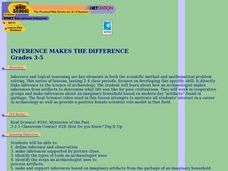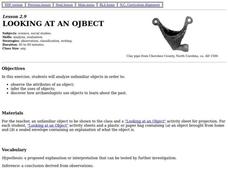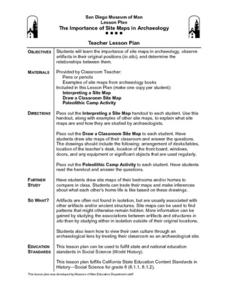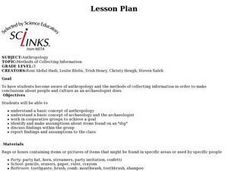Curated OER
Archeology of the Future
Students are introduced to the basic vocabulary of archeology. Using the vocabulary, they classify artifacts and make inferences about their uses. In groups, they create a chart for the criteria needed to analyze artifacts and share...
Curated OER
Mapping and Excavating a Jello Mold
Fifth graders, in groups, map the three layers of different colored jello layers in molds and note the placement of fruit in them. On the grid paper they draw each grape, raisin, or other object and carefully remove each layer. After...
Curated OER
Social Studies: Cooking Methods - Past and Present
Fourth graders identify geographic regions (Texas' Edwards Plateau) and sequence steps in the hot rock cooking process. They compare and contrast prehistoric and contemporary cooking methods. Students conduct online research and record...
Curated OER
Mapping with a Compass: A Simulated Survey
Students use compasses and grids to map the locations of artifacts found in a simulated dig site. In groups, they role-play as future archeologists excavating a school site. Groups begin at their assigned datum and site the artifacts...
Curated OER
Natural Regions of Texas Archeology
Seventh graders, in groups or individually, research Texas archeological sites and create a mural of the natural regions and the sites found in them. They conduct online research to discover the importance, age, and the inhabitants of...
Curated OER
Coordinate Grid: Mapping an Archaeological Site
Students examine how archaeologists preserve context of sites through use of rectangular grid or Cartesian coordinate system, and develop sense of distance by pacing off and estimating distances.
Curated OER
Discovering Pi
Students investigate the math concept of Pi (specifically, what pi is, the significance and how it is used in the real world). This is a hands on lesson plan in which the students actively participate with their investigations.
The...
Curated OER
Hands-on History of Pottery
Students make pottery in the same evolutionary order as archeology indicates. They begin with simple pinch pots and then move to plain coil pots, manipulative decoration, and surface decoration. For each type of pot they discuss the...
Curated OER
Investigating History with Kidd Gloves
Students act as historical archeologists and use their analytical skills to deduce, from lists of items related to historic figures, accurate details about the lives of those people.
Curated OER
Shells on the Mountain Top?
Pupils work in groups to remove fossils from sediments, classifying as many organisms and parts of organisms as possible into major groups. They study the data from each formation and make conclusions about the types of organisms and...
Curated OER
Vocabulary bingo
Students participate in a game in which they practice vocabulary associated with the archeological process. They create a set of index cards in which they list one vocabulary word and use a piece of candy to symbolize it already being...
Curated OER
Inference Makes the Difference
Students explore how archaeologists make inferences from artifacts to explore what life was like in the past. In this archaeology lesson, students work in groups and make inferences about an imaginary household based on modern day...
Curated OER
Culture Everywhere
Students study their culture while filling in a chart that shows how culture meets basic human needs. They examine the role of archaeologists in studying people from past cultures.
Curated OER
Name That Point!
Young scholars compare projectile point attributes, identify and classify points, and match projectile points to a chronology.
Curated OER
Looking At An Object
Students observe the attributes of an object, infer their uses, and discover how archaeologists use objects to explore the past.
Curated OER
Mending Pottery
Learners act as archaeologist and mend broken pottery to see what they can learn.
Curated OER
Experimental Archaeology: Making Cordage
Students make a cordage and use an activity sheet to experience a skill that ancient Native American in North Carolina neded for everyday life.
Curated OER
Fossilworks
Students research fossils and fossil formation. They explain how fossils are formed, identify fossil formations and use casting plaster to produce fossil replicas.
Curated OER
The Importance of Site Maps in Archaeology
Students consider the importance of site maps in archeology. They interpret site maps, draw site maps of their classroom and home and then participate in simulated Paleolithic archeological camp activity.
Curated OER
Methods of Collecting Information
Third graders examine a bag or box of soil containing items that they dig for. Their task is to become detectives to make conclusions about the area from which the items came as real archaeologists do.
Curated OER
The Mesoamerican Mystique
Students gain a better understanding of the cultural diversity in the northern region of Central America. They engage in a lesson which focuses on research, archaeology, historical videos, and travel highlights.
Curated OER
I Can Be An Archaeologist Book Share
Students read and discuss the book, I Can Be An Archaeologist by Robert B. Pickering, and become archaeologists, themselves, as they examine, sort, and record items in a paper bag and trash from their classroom, as well as 2 others.
Curated OER
Intrigue of the Past: North Carolina's First Peoples
Young scholars study the archeological history of North Carolina in this series of lessons.
Curated OER
Celebrate Native American Cultures
Fourth graders use video, CD-ROMS, discussion, books and maps to further their understanding of the Wisconsin Native American's culture and contributions to American society.

























